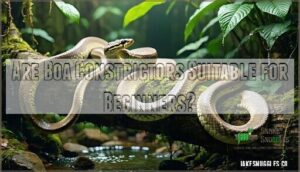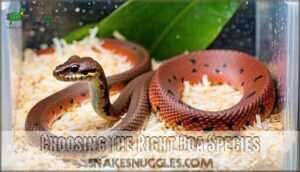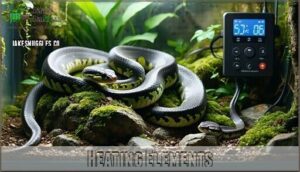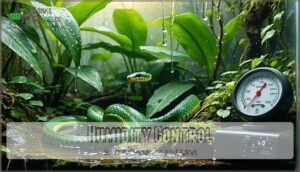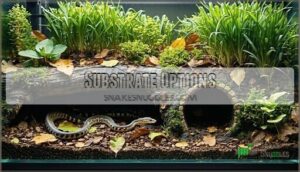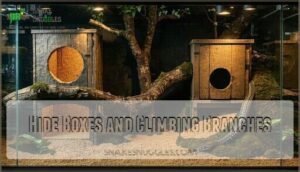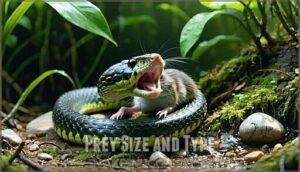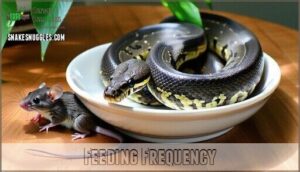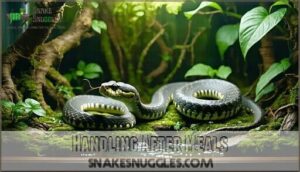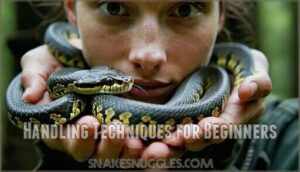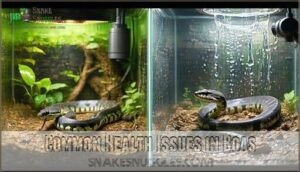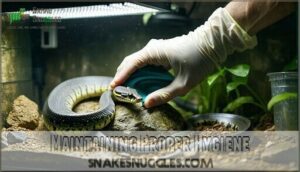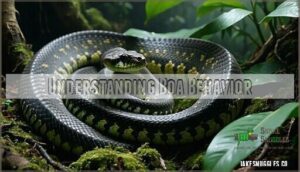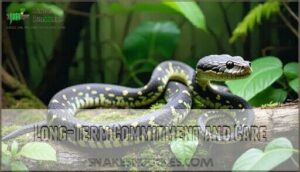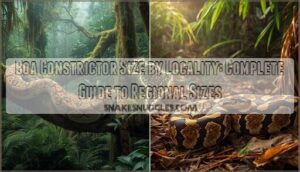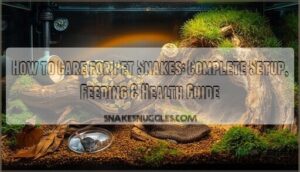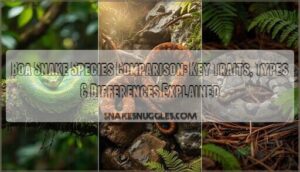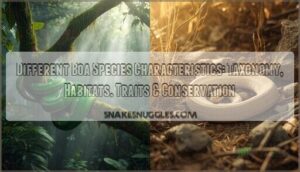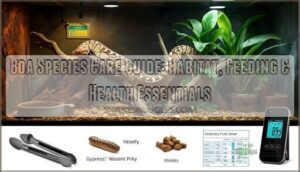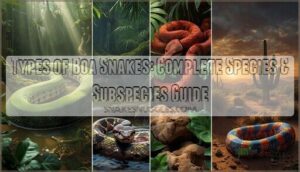This site is supported by our readers. We may earn a commission, at no cost to you, if you purchase through links.
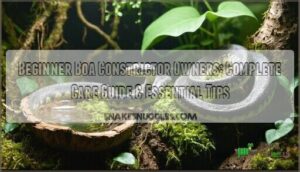
You’ll need proper enclosures with temperature gradients (88-92°F basking, 78-80°F cool side), humidity control, and secure heating systems. Boas eat pre-killed frozen prey every 1-2 weeks and require minimal handling to avoid stress.
They’re generally docile when handled correctly, but respect their strength. Your success depends on understanding their specific needs, maintaining consistent environmental conditions, and preparing for the long-term financial investment. The setup details matter more than you might think.
Table Of Contents
- Key Takeaways
- Are Boa Constrictors Suitable for Beginners?
- Choosing The Right Boa Species
- Essential Equipment for Boa Enclosures
- Creating The Ideal Habitat
- Feeding Your Boa Constrictor
- Handling Techniques for Beginners
- Common Health Issues in Boas
- Maintaining Proper Hygiene
- Understanding Boa Behavior
- Long-Term Commitment and Care
- Frequently Asked Questions (FAQs)
- Are boa constrictors a good beginner pet reptile?
- How long does a boa constrictor take to get used?
- Do boa constrictors need maintenance?
- Do boa constrictors eat snakes?
- Are Boa Constrictors docile?
- What is the lifespan of a boa constrictor?
- Are boa constrictors good pets for beginners?
- What is the best beginner boa constrictor?
- Do boa constrictors bond with their owners?
- Do boa constrictors like to be handled?
- Conclusion
Key Takeaways
- You’re committing to decades of care – Boa constrictors live 20-30 years and grow 6-10 feet long, so you’ll need substantial space, proper equipment, and consistent financial investment throughout their entire lifespan.
- Environmental conditions aren’t negotiable – You must maintain precise temperature gradients (88-92°F basking, 78-80°F cool side) and 60-75% humidity levels to prevent serious health issues like respiratory infections and scale rot.
- Respect their size and strength from day one – These aren’t typical starter snakes, so you’ll need to learn proper handling techniques, support their full body weight, and understand that they tolerate rather than enjoy being handled.
- Prevention beats treatment every time – You’ll save money and stress by maintaining clean enclosures, establishing regular feeding schedules with pre-killed prey, and finding an exotic veterinarian before problems arise.
Are Boa Constrictors Suitable for Beginners?
Boa constrictors aren’t your typical beginner snake species, but they’re not impossible either.
Think of them as the "intermediate" option that ambitious newcomers can handle with proper preparation.
Beginner suitability depends largely on your commitment level.
These pet snakes have generally calm temperaments, but temperament concerns arise when they feel threatened or stressed.
You’ll face handling difficulty simply due to their impressive size – adults can reach 6-8 feet and weigh 20-60 pounds.
Size challenges extend beyond handling.
You’ll need a substantial enclosure, sturdy equipment, and space in your home.
The cost commitment is significant too – expect $500+ for initial setup, plus ongoing monthly expenses around $30.
However, boa constrictors make rewarding pets for dedicated beginners willing to learn proper reptile care.
They’re hardier than many species and respond well to consistent, gentle handling.
If you’re ready for a long-term commitment (20+ years) and can invest in proper equipment, a boa might be your perfect beginner pet.
Choosing The Right Boa Species
Selecting the right boa species makes all the difference in your success as a first-time owner.
Central American and Colombian red-tail boas offer the best combination of manageable size, calm temperament, and straightforward care requirements for beginners, making them a great choice for those new to boa ownership due to their manageable size.
Common Boa
Common boas make perfect beginner snake species for new owners.
These adaptable reptiles display calm temperament variations and manageable sizes, typically reaching 6-8 feet.
Boa morphs offer stunning color patterns, from wild-type browns to striking pastels.
Their wild origins from Central America contribute to hardy constitutions.
With proper boa constrictor care and gentle snake handling, they become docile companions for decades.
Red-Tail Boa
Choosing a Red-Tail Boa means embracing stunning beauty with responsibility.
These Boa constrictors showcase vibrant Colombian locale patterns and impressive 6-10 foot lengths. Argentine Boa and Peruvian Boa varieties offer unique Red-Tail morphs.
Your enclosure setup needs extra space, while temperature control and humidity levels remain standard. Expect higher food costs as your redtail boa grows into its magnificent adult size.
They thrive in environments ranging from tropical rainforests to arid regions.
Dwarf Boa Species
Several dwarf boa morphs offer perfect starter snakes for new owners.
These compact constrictors reach just 4-6 feet, making enclosure setup far simpler than their larger cousins.
You’ll find temperament differences between morphs, but most display calm, docile personalities ideal for handling practice.
Enclosure considerations include smaller vivariums while maintaining proper temperature control and humidity levels.
Feeding schedules remain consistent with adult prey every 2-3 weeks.
Health concerns mirror standard boa constrictor care, though their size reduces potential complications.
Central American varieties like Nicaraguan and Honduran dwarf boas prove most beginner-friendly.
Their manageable size, gentle nature, and straightforward pet snake requirements make them excellent first reptiles.
Essential Equipment for Boa Enclosures
Setting up your boa’s enclosure requires specific equipment to create a safe environment that meets their basic needs.
You’ll need the right combination of heating elements, humidity controls, proper substrate, secure hiding spots, and climbing branches to guarantee your snake stays healthy and stress-free.
Enclosure Size and Type
Your boa constrictor care starts with selecting the right snake enclosure. Adult snakes need minimum dimensions of 6-8 feet long, 2-3 feet wide, and 2-3 feet tall.
Choose between arboreal vs terrestrial setups based on your boa’s climbing preferences. Secure enclosures prevent escapes, while vivarium size should exceed 90 gallons.
Maintain substrate depth around two inches for proper snake habitat setup. Many resources are available that discuss the ideal enclosure products.
- Escape-proof latches to prevent midnight snake adventures
- Adequate ventilation for healthy air circulation throughout the habitat
- Multiple hide boxes positioned at different temperature zones
- Horizontal floor space allowing natural movement and exercise patterns
- Sturdy climbing branches or shelves for enrichment and exploration
Heating Elements
Ceramic heat emitters and heat mats provide consistent warmth without disrupting your snake’s day-night cycle.
Position heat sources on one side to create proper temperature gradients. Always use temperature controllers to prevent overheating – pulse-proportional thermostats work best.
Heat pad safety requires placing mats under substrate, never directly touching your boa. Infrared bulbs offer excellent basking bulb wattage options.
Combining heat mats and ceramic bulbs provides both belly and air heating, which can offer a more complete thermal gradient.
Humidity Control
Proper humidity control keeps your boa healthy and prevents respiratory problems.
Maintain humidity levels between 60-75% using a reliable hygrometer placement near your snake’s favorite spots.
Here’s your humidity management toolkit:
- Misting frequency: Spray warm water every other day to boost moisture
- Water bowl size: Use wide, shallow dishes for drinking and soaking
- Mold prevention: Guarantee good ventilation to avoid fungal growth
Substrate Options
Your substrate choice affects your boa’s health and your wallet. The right reptile substrate provides substrate safety while supporting humidity retention and odor control.
Some snake substrate options encourage burrowing behavior, while others focus on easy maintenance.
Here are five substrate options for your boa constrictor:
- Newspaper and paper towels – Cheapest option, easy cleaning, perfect for quarantine setups
- Cypress mulch substrate – Excellent humidity retention, natural appearance, moderate cost
- Coconut fiber – Mold-resistant, sustainable choice, holds moisture well for humidity control
- Orchid bark – Visually appealing, great moisture retention, higher cost but natural look
- Aspen shavings – Light texture, allows burrowing behavior, requires additional humidity management
Cost comparison shows paper products win for budget-conscious owners, while natural substrates offer better environmental mimicry.
For ideal health, boa enclosures should maintain humidity between 60-70%.
Hide Boxes and Climbing Branches
When setting up your boa constrictor habitat, hide boxes and climbing branches create a comfortable, enriching environment.
Place one hide box at each temperature end for ideal thermoregulation.
Choose branches that support your snake’s weight securely.
A suitable boa hide box is vital for the snake’s well-being.
| Feature | Hide Boxes | Climbing Branches |
|---|---|---|
| Material Safety | Non-toxic plastic, cork bark | Cleaned hardwood, PVC pipes |
| Size Matters | Snug fit, body-width opening | Diameter matches snake’s girth |
| Hide Placement | Cool and warm zones | Secure mounting, no wobbling |
Proper snake enclosure accessories guarantee your boa feels secure while promoting natural behaviors through enrichment variety.
Creating The Ideal Habitat
You’ll need to balance three key elements to create a proper habitat for your boa constrictor: temperature, humidity, and lighting.
Getting these environmental factors right guarantees your snake stays healthy and behaves naturally in its new home, which is crucial for its overall well-being and habitat.
Temperature Gradient
Temperature gradient matters most for your boa constrictor’s health.
Create a basking spot at 90-92°F using heat sources like ceramic heaters or under-tank pads. The cool zone should stay 78-80°F.
This thermal regulation mimics nature, helping digestion and shedding. Use digital thermometers for monitoring temperatures accurately.
Your snake will move between zones as needed. A proper temperature gradient also prevents respiratory infections.
Humidity Levels
Your boa constrictor thrives when humidity levels stay between 60-75%.
Humidity monitoring prevents shedding problems and protects respiratory health. This ideal range supports healthy skin and breathing.
Increase misting frequency during shedding cycles to reach 80%. Too much moisture causes scale rot, while too little creates stuck shed.
Use a digital hygrometer to track levels accurately and adjust accordingly.
Lighting Requirements
Your boa constrictor doesn’t need UVB lighting like other reptiles, but establishing proper light cycles keeps them healthy.
Use LED options or basking lamps to create a 12-hour day-night schedule.
Night lighting should be minimal or absent, and this reptile lighting setup helps regulate your snake’s natural behaviors and supports healthy brumation cycles throughout the year.
Feeding Your Boa Constrictor
Your boa constrictor’s diet consists entirely of whole prey animals like mice, rats, and rabbits that match your snake’s body size.
You’ll need to establish a proper feeding schedule, understand correct prey sizing, and know when it’s safe to handle your snake after meals.
Prey Size and Type
Your boa constrictor diet should match your snake’s size and age. Young boas thrive on mice, while adults require rats, rabbits, or chickens. Choose prey no wider than your snake’s thickest body section to prevent choking or regurgitation.
Rodent Variety options for your pet snake feeding routine:
- Frozen mice – convenient, safe storage for consistent nutritional needs
- Live rats – natural hunting behavior, though requiring careful supervision
- Day-old chicks – excellent calcium source for growing juveniles
- Adult rabbits – protein-rich meals for large, mature specimens
- Guinea pigs – alternative prey items when sourcing challenges arise
Frozen vs. Live prey both work well. Frozen options eliminate Sourcing Challenges while live prey stimulates natural behaviors. Your reptile feeding guide should prioritize Prey Digestion safety over convenience.
Feeding Frequency
Once you’ve determined proper prey size, timing becomes your next priority. Your boa constrictor diet schedule varies substantially with age and season. Young snakes need consistent fuel for rapid growth, while adults require less frequent meals.
Juvenile Frequency starts with weekly feedings for hatchlings under twelve months. As they mature, Adult Schedules shift to monthly meals. During winter Brumation Effects, your snake may refuse food entirely – don’t panic, this temporary fasting is normal.
Matching prey size is also vital to prevent regurgitation. Monitor your snake’s body condition for Obesity Prevention. Overfeeding creates health problems faster than underfeeding. Wait 48-72 hours after meals before handling to avoid Regurgitation Risks.
- Hatchlings: Weekly snake feeding schedule
- Juveniles: Every 5-7 days for ideal growth
- Young adults: 10-14 day intervals work best
- Mature adults: Monthly reptile feeding guide suffices
- Winter months: Expect appetite changes during brumation
- Obese snakes: Reduce frequency, not prey size
- Sick snakes: Consult veterinarian before adjusting pet snake feeding
- Record keeping: Track dates and prey weights consistently
Handling After Meals
After feeding comes a waiting game that protects your snake’s health. Wait at least 48 hours before handling to prevent regurgitation risks and allow proper digestion time.
This rest period reduces stress and supports your boa’s natural digestion process. Your feeding schedule should account for this hands-off period.
Watch your snake’s body language for handling readiness. Quick head movements signal restlessness, while hissing indicates stress.
Safe handling practices mean respecting these signals.
Body Language Likely Emotion
Handling Techniques for Beginners
Learning to handle your boa correctly prevents stress for both you and your snake, while building the trust needed for a calm, well-adjusted pet.
You’ll need to support your boa’s body properly and practice consistent, gentle techniques that help your snake feel secure during every interaction.
Proper Support
Proper body support forms the foundation of safe boa constrictor handling techniques.
Use a paper towel roll or snake hook to gently tap your pet snake before pickup—this prevents bites by signaling your intentions.
Wait for slow tongue flicks indicating calmness.
Support the entire body with both hands, maintaining a loose grip that allows natural movement.
When your boa wraps around you, don’t panic—this safe coiling provides stability, not aggression.
Guide the head gently if needed, keeping movements slow and deliberate for reducing stress.
Building Trust
Trust develops through patience and consistent interaction with your boa constrictor.
Reading signals from your snake helps you understand its temperament and comfort level. Gentle handling builds confidence while avoiding stress keeps your boa docile during sessions.
Essential trust-building strategies include:
- Start with brief, gentle handling sessions to build familiarity gradually
- Use positive reinforcement by offering calm, predictable interactions
- Read your boa’s body language – tensing means it needs space
- Maintain consistent interaction schedules to establish routine comfort
- Apply proper handling techniques with full body support always
Common Health Issues in Boas
Respiratory infections, scale rot, and parasites are the three most common health problems you’ll encounter as a boa owner.
You can prevent most of these issues by maintaining proper temperature, humidity, and cleanliness in your snake’s enclosure.
Respiratory Infections
Respiratory infections rank among the most serious snake health problems for your boa constrictor. These reptile health issues develop when temperatures drop too low or humidity levels aren’t maintained properly.
Watch for these RI symptoms:
- Wheezing, clicking, or whistling sounds during breathing
- Mouth breathing or gaping
- Nasal discharge or bubbly saliva around the mouth
Prevention tips include maintaining proper enclosure conditions and good ventilation. Treatment options require immediate veterinary attention – antibiotics are essential.
The humidity impact on recovery means keeping your snake’s environment ideal. Never delay seeking professional help, as vet importance can’t be overstated for respiratory infections.
Scale Rot
Scale rot strikes when your boa constrictor’s environment becomes a breeding ground for bacteria and fungi. This serious reptile health issue develops from poor sanitation, incorrect humidity levels, and temperature problems that weaken your snake’s natural defenses.
Identifying Scale Rot in your boa constrictor:
- Discolored, cracked, or crusty scales on the belly and sides
- Raised scales with blood pooling underneath creating a bubble effect
- Blisters forming where your snake contacts wet substrate
- Foul, musty odor coming from infected areas
- Open wounds or ulcers that won’t heal properly
- Loss of appetite and decreased activity levels
Preventing Scale Rot requires maintaining proper humidity levels between 60-75% and keeping the enclosure spotlessly clean. Remove uneaten food within 24 hours and change water regularly.
Treating Scale Rot starts with gentle cleaning using chlorhexidine solution, followed by antibiotic ointment application. Advanced Scale Rot cases need immediate veterinary attention, as your reptile may require prescription antibiotics or surgical debridement to prevent the infection from spreading throughout the body.
Parasites
Parasites can turn your snake’s life upside down if left unchecked. External parasites like mites appear as tiny moving dots around your boa’s eyes and skin folds, while internal parasites affect digestion and overall health.
Identifying Parasites early prevents serious complications. Preventing Infestations requires quarantine protocols for new animals and regular enclosure cleaning. Treating Parasites involves thorough enclosure disinfection and Vet Consultations for proper medication.
Here are five critical parasite prevention steps:
- Quarantine new snakes for 30-60 days before introduction
- Schedule annual fecal exams with reptile veterinarians
- Inspect your boa weekly for mites or unusual behavior
- Maintain proper humidity levels to prevent parasite-friendly conditions
- Clean water bowls and substrate regularly to eliminate breeding grounds
Maintaining Proper Hygiene
Keeping your boa’s environment clean prevents disease and creates a healthy home for your snake.
You’ll need to establish regular cleaning routines for the enclosure, disinfect all equipment properly, and maintain good personal hygiene when handling your boa, to ensure a clean and healthy environment.
Cleaning The Enclosure
Clean your snake enclosure weekly with spot-cleaning for waste removal between deep cleans.
Remove soiled substrate immediately to prevent odor control issues. Replace water bowls every few days for proper water sanitation.
During substrate cleaning, remove all decorations and scrub surfaces with reptile-safe cleaners. This snake enclosure maintenance routine keeps your boa healthy and comfortable.
Disinfecting Equipment
Safe disinfectants like F10SC or Chlorhexidine require proper dilution ratios for your reptile enclosure equipment.
Follow manufacturer instructions for contact time – typically 10-15 minutes before rinsing thoroughly.
Weekly disinfecting frequency prevents disease transmission between your snake and reptile pet supplies.
This reptile health care practice guarantees reptile handling safety and protects your boa’s well-being through proper snake handling tips.
Personal Hygiene
Proper hygiene protects both you and your boa constrictor from potential health risks.
Hand washing before and after handling prevents zoonotic diseases that can transfer between species.
Use antibacterial soap and scrub for twenty seconds to remove oils and bacteria from skin contact.
Consider wearing gloves with defensive juveniles, as their temperament improves with age.
Throughout their twenty-plus year lifespan, consistent safe handling practices become second nature.
Your hygiene routine should include:
- Washing hands thoroughly before touching your snake
- Cleaning hands immediately after handling sessions
- Using hand sanitizer to maintain consistent scent
- Wearing protective gloves when working with aggressive behavior
Consistent practice of these habits will lead to a healthier relationship between you and your boa constrictor, emphasizing the importance of proper hygiene and consistent safe handling.
Understanding Boa Behavior
You’ll notice your boa shows predictable patterns throughout the year, from regular shedding cycles to seasonal changes in appetite and activity.
Understanding these natural behaviors helps you provide better care and prevents unnecessary worry when your snake acts differently during normal processes like brumation or pre-shed periods, which can be critical for its health and well-being, especially during periods of pre-shed.
Shedding Process
Your boa’s shedding process follows a predictable shed cycle that you’ll learn to recognize.
The reptile shedding process begins when your snake’s skin becomes dull and its eyes turn milky blue – these opaque eyes signal the start of the snake shedding process.
Shedding signs appear 7-10 days before the actual shed occurs.
| Phase | Duration | Your Actions |
|---|---|---|
| Pre-shed | 7-10 days | Increase humidity to 80-90% |
| Blue phase | 2-3 days | Avoid handling completely |
| Shed day | 1 day | Check for retained shed |
Humidity importance can’t be overstated during this time.
Shedding frequency decreases as your boa ages.
Aiding shedding involves providing rough surfaces and maintaining proper moisture levels.
Brumation
Winter triggers your boa’s natural slowdown period called brumation—the reptile equivalent of hibernation. Unlike deep sleep, your snake remains semi-alert and occasionally wakes for water.
Understanding this behavior helps you provide proper snake care during challenging months.
Key brumation indicators include:
- Appetite Loss – Your boa stops eating as metabolism slows dramatically
- Hydration During brumation remains essential – always provide fresh water access
- Temperature Effects determine brumation length – cooler conditions extend dormancy periods
Captive boas may skip brumation if snake temperature humidity levels stay ideal year-round.
These snake behavior patterns are normal snake care challenges beginners face.
Breeding Behavior
Mating rituals occur during dry seasons when females release pheromones attracting multiple males.
Males compete through wrestling matches to earn breeding rights. The gestation period spans 100-150 days before females deliver 10-65 live babies.
Understanding these snake breeding practices helps you recognize behavioral changes.
Most pet owners avoid reptile breeding due to complex neonate care requirements and genetic considerations.
Females should reach minimum breeding size before mating to guarantee their health.
Long-Term Commitment and Care
When you adopt a boa constrictor, you’re committing to more than 20 years of care, as these snakes live exceptionally long lives with proper attention.
You’ll need to plan for their growth from small juveniles to 6-8 foot adults, which means upgrading enclosures and adjusting feeding schedules throughout their lifetime.
Lifespan Expectations
Your boa constrictor’s average lifespan reaches 20-30 years in captivity, making this a true generational commitment.
Factors affecting their longevity include proper husbandry, veterinary care, and genetics.
Some exceptional specimens live beyond 40 years, demonstrating remarkable snake longevity.
Consider legacy planning for your pet’s full lifespan – you’re basically adopting a family member who’ll accompany you through decades of life changes.
Growth Rate
Understanding your boa’s growth pattern helps you plan for proper housing and feeding throughout their lifespan.
Young boas grow rapidly during their first two years, slowing considerably as adults. Growth factors include genetics, feeding frequency, and overall health.
Most boas reach 6-8 feet by maturity, though some exceed 10 feet depending on their genetic potential.
Key growth considerations:
- Feeding impact: Overfeeding accelerates growth but causes obesity, while underfeeding stunts development
- Shedding frequency: Growing juveniles shed monthly; adults shed 3-4 times yearly
- Enclosure size: Upgrade housing as your snake size increases to maintain proper space ratios
Veterinary Care
While your boa constrictor can live 20-30 years, finding qualified exotic vets becomes your lifeline for long-term success.
Annual check-ups aren’t just recommended—they’re essential for catching problems before they escalate into emergency signs like wheezing, mouth breathing, or difficulty shedding.
Preventative care starts with you maintaining proper humidity and temperature, but your reptile vet will screen for common ailments including respiratory infections, scale rot, and parasites.
When bringing home a new boa, quarantine protocols require isolating them for 3-6 months before introducing them to other snakes.
Your veterinary care partner should specialize in reptile vet care and understand snake health care needs.
They’ll establish a snake disease prevention plan suited to your boa’s age and health status.
Regular common health issues screenings catch problems early, saving you money and your snake unnecessary suffering.
Don’t wait for symptoms—prevention beats treatment every time.
Frequently Asked Questions (FAQs)
Are boa constrictors a good beginner pet reptile?
These magnificent serpents aren’t beginner-friendly pets.
You’ll need extensive experience, substantial space, and significant financial commitment.
Their size, strength, and specialized care requirements make them challenging for novice reptile keepers to handle safely, requiring extensive experience.
How long does a boa constrictor take to get used?
Your boa constrictor will typically take 2-6 months to fully adjust to you and their new environment.
With consistent, gentle handling for 10-15 minutes daily, most boas become docile and comfortable by 18 months of age.
Do boa constrictors need maintenance?
Yes, you’ll need regular maintenance for your boa.
Daily water changes, weekly cage cleaning, monthly deep sanitizing, temperature monitoring, humidity checks, and periodic substrate replacement keep your snake healthy and comfortable.
Do boa constrictors eat snakes?
In the wild, roughly 15% of boa constrictor diets include other snakes.
Your pet boa won’t eat snakes since you’ll feed them pre-killed rodents like mice and rats, eliminating any snake-eating behavior.
Are Boa Constrictors docile?
Captive-bred boa constrictors are generally docile and calm when handled regularly.
You’ll find they become quite tame with consistent, gentle handling, though juveniles may be slightly nippy until around 18 months old.
What is the lifespan of a boa constrictor?
Think you’re getting a pet for a few years?
Think again.
Your boa constrictor will outlive your college years, first job, and maybe your first mortgage—these serpents live over 20 years with proper care.
Are boa constrictors good pets for beginners?
Boa constrictors can make good beginner pets if you’re prepared for their 20+ year commitment, large enclosures, and specific care requirements. They’re docile when handled regularly but need dedicated owners.
What is the best beginner boa constrictor?
Like choosing your first car, Central American and Colombian red-tail boas are your best starter models.
They’re naturally docile, manageable in size, and forgiving of beginner mistakes while you’re learning the ropes.
Do boa constrictors bond with their owners?
Snakes don’t form emotional bonds like mammals do. However, your boa can recognize you through scent and handling patterns, becoming calmer and more docile with consistent, gentle interaction over time.
Do boa constrictors like to be handled?
Absolutely not initially – your boa will tolerate handling rather than enjoy it.
However, with consistent gentle sessions lasting 10-15 minutes daily, they’ll become surprisingly calm and docile, making handling stress-free for both of you.
Conclusion
Mastering boa care transforms anxious beginners into confident reptile keepers through dedication and proper knowledge.
You’ve learned the essential requirements for housing, feeding, and handling these magnificent serpents safely.
Remember that beginner boa constrictor owners succeed by maintaining consistent temperatures, proper humidity, and respecting their snake’s strength.
Your commitment to following these guidelines guarantees both you and your boa will thrive together for decades.
Start with quality equipment, stay patient during the learning process, and enjoy this rewarding journey.

